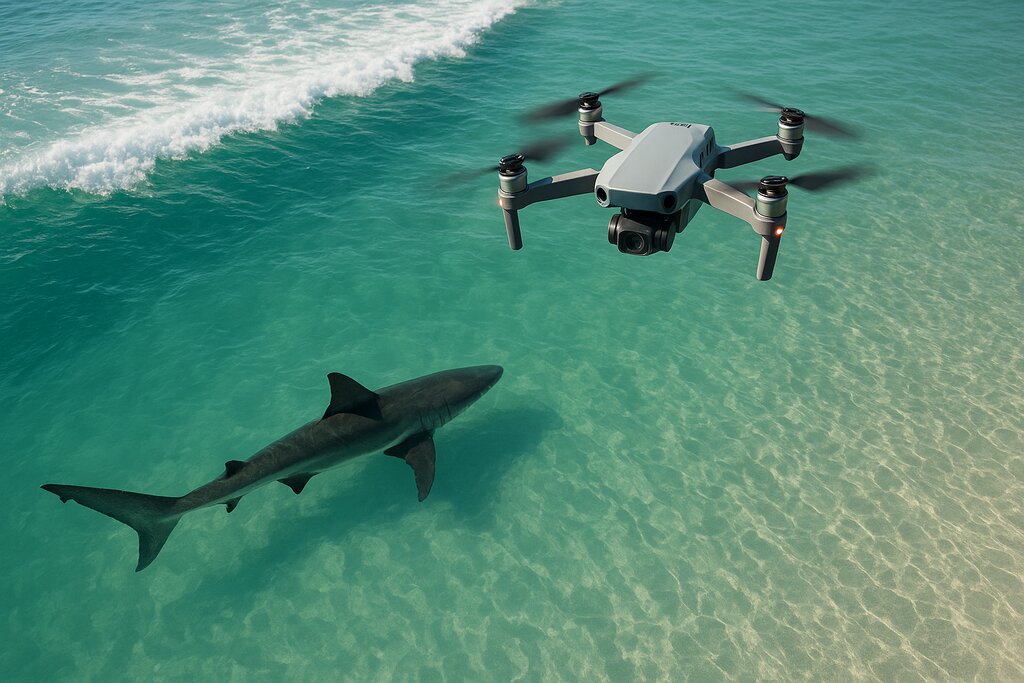Drone Shark Detection in Australia: Lifesaving Technology from the Sky
Australia’s beaches are some of the most beautiful and popular in the world, but they are also home to some of the ocean’s most formidable predators. In recent years, technology has come to the aid of beachgoers and surf lifesaving services through drone shark detection. These smart aerial tools are helping prevent incidents and save lives, giving real-time updates and alerts about sharks in the vicinity. With the rise of drone technology, shark spotting has entered a new era of safety and efficiency.
How Drone Shark Detection Works
Drone shark detection uses high-resolution cameras, AI-powered image recognition, and live feeds to monitor coastal waters. Drones fly regularly over the ocean and along beaches, scanning the ocean surface and transmitting footage to trained operators on land. Some systems integrate AI that can detect and identify the shape, movement, and size of marine creatures – distinguishing sharks from dolphins, rays, or surfers.
When a shark is detected, the operator can issue warnings, alert emergency services, or even deploy drones with audio systems to advise swimmers and surfers to exit the water. These proactive responses have proven effective at several locations across Australia.

Is There a Drone That Detects Sharks?
Yes, there are multiple commercial drones being used in drone shark detection programs across Australia. These drones are typically equipped with 4K or higher-resolution cameras, real-time video streaming capabilities, and GPS tracking. More sophisticated versions integrate machine learning to automatically flag the presence of sharks. DJI drones, such as the Mavic 4 and Matrice series, are commonly used due to their flight stability, payload options, and high-quality imaging.
While off-the-shelf drones can be adapted for shark detection, some systems are custom-built for surf lifesaving purposes. These include thermal imaging, floatation drop mechanisms, and integration with public alert systems.
Drone Shark Sightings Are on the Rise
With greater deployment of drones, drone shark sightings have increased significantly. This does not necessarily mean there are more sharks, but rather, we are now better at seeing them. From Byron Bay to Esperance, drones are spotting sharks that would have otherwise gone unnoticed.
Drone footage provides authorities with precise shark location data, allowing them to make informed decisions about beach closures or safety warnings. It also provides valuable behavioural data for marine researchers studying shark movement and population trends along the coast.
The Drone Shark App: Public Awareness in Real Time
The Drone Shark App allows beachgoers to receive live alerts, footage, and updates about local shark sightings captured by drone patrols. This app has grown in popularity among Australian coastal communities, offering a sense of security and transparency.
Users can receive real-time video of shark activity, allowing them to make safe decisions about entering the water. It also offers updates about drone patrols, weather conditions, and beach closures – making it a go-to tool for both surfers and families alike.
Australian Surf Lifesavers Using Drones to Spot Sharks
Australian surf lifesavers using drones to spot sharks is no longer a pilot program – it’s standard practice in many states. Surf Life Saving NSW and Surf Life Saving WA have integrated drone patrols into their daily operations, particularly during peak beach seasons.
Drones provide a bird’s eye view that no tower or jet ski can replicate. By covering larger areas in less time and offering immediate transmission of data, drones have become essential for improving water safety. They also offer quicker response times in emergencies, including dropping inflatable buoys to swimmers in distress.
Esperance Shark Attack Drone Response
The tragic Esperance shark attack drone incident in Western Australia was one of the key moments that sparked a nationwide push for drone-based shark detection. Following several fatal attacks in the region, local councils and emergency services began incorporating drone surveillance to enhance early warning capabilities.
Since implementation, multiple sightings have been captured on drone footage, allowing local authorities to close beaches before any harm could occur. These proactive measures have been widely supported by the community and are being adopted across more coastal regions in response.
Drone Footage of Shark Attacks: Educating and Preventing
Unfortunately, drone footage of shark attacks has surfaced in some coastal incidents, including shark interactions with surfers and swimmers. While these videos can be confronting, they have become vital teaching tools in both public awareness campaigns and professional training courses.
At Flying Glass, we support responsible footage use and believe that drone footage – when used ethically – can help reduce risks. Our training programs also include situational awareness, coastal surveillance techniques, and risk mitigation strategies.
Drone Shark Attack Response and Prevention
The term drone shark attack might conjure up a dramatic image, but in practice, drones are being used to reduce attacks, not cause them. Timely drone surveillance can mean the difference between a quiet beach day and a critical incident.
Australia’s proactive stance on integrating drones into shark prevention efforts is saving lives. The technology continues to evolve, and so do our capabilities in protecting the public through efficient aerial monitoring.
Drones for Shark Spotting: Capabilities and Limitations
Drones for shark spotting excel in clear, sunny conditions when water visibility is high. However, they are less effective during cloudy days, rough surf, or turbid water. This is where pairing human interpretation with AI technology comes in – blending the strengths of machine learning with experienced lifeguards who know local water conditions.
Despite some limitations, drones offer far more than visual identification. They can relay GPS coordinates, capture evidence for scientific research, and provide operational support for lifeguards in real time.
Drone Shark Spotting: What You Need to Know
Drone shark spotting is expanding across Australia, especially in high-risk areas. Councils, surf clubs, and government bodies are investing in drone fleets and operator training to ensure maximum safety and efficiency.
For those wanting to get involved in drone shark detection, training and licensing are essential. At Flying Glass, we offer accredited drone training courses that equip you with the skills and legal permissions required to fly drones for commercial use, including coastal monitoring roles.
From beach patrols to marine research, the opportunities for certified drone operators are growing rapidly. Whether you’re a professional looking to enhance your credentials or an organisation seeking safer beach monitoring methods, drone shark detection training is a valuable step forward.
Commercial Drone Services and Support
If you’re a council, surf lifesaving organisation, or production company without the necessary permissions or experience to carry out drone shark detection safely and legally, we can help. At Flying Glass, we offer expert drone services, including coastal surveillance and high-resolution aerial videography tailored to your needs.
All operations are carried out by fully licensed drone pilots with extensive experience in high-risk and coastal environments. We understand the legal landscape and can ensure all work is conducted safely, ethically, and in full compliance with CASA regulations.
Learn the Rules: Enrol in Drone Training
If you’d prefer to gain the skills yourself, we also run certified drone training courses across Australia. Whether you’re an individual keen to join the growing field of drone shark spotting or a business looking to upskill your staff, our RePL course will give you the edge.
Our training covers everything from safety and weather assessment to coastal risk operations and emergency response procedures – ideal for those aiming to enter the field of drone shark detection.

